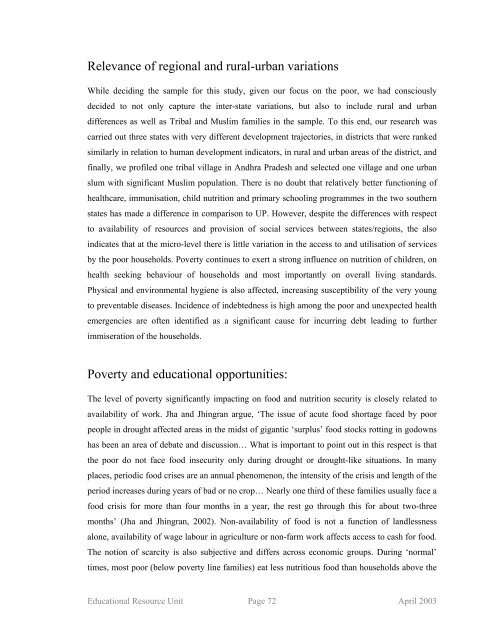Snakes and Ladders - ERU Consultants Pvt. Ltd.
Snakes and Ladders - ERU Consultants Pvt. Ltd.
Snakes and Ladders - ERU Consultants Pvt. Ltd.
You also want an ePaper? Increase the reach of your titles
YUMPU automatically turns print PDFs into web optimized ePapers that Google loves.
Relevance of regional <strong>and</strong> rural-urban variations<br />
While deciding the sample for this study, given our focus on the poor, we had consciously<br />
decided to not only capture the inter-state variations, but also to include rural <strong>and</strong> urban<br />
differences as well as Tribal <strong>and</strong> Muslim families in the sample. To this end, our research was<br />
carried out three states with very different development trajectories, in districts that were ranked<br />
similarly in relation to human development indicators, in rural <strong>and</strong> urban areas of the district, <strong>and</strong><br />
finally, we profiled one tribal village in Andhra Pradesh <strong>and</strong> selected one village <strong>and</strong> one urban<br />
slum with significant Muslim population. There is no doubt that relatively better functioning of<br />
healthcare, immunisation, child nutrition <strong>and</strong> primary schooling programmes in the two southern<br />
states has made a difference in comparison to UP. However, despite the differences with respect<br />
to availability of resources <strong>and</strong> provision of social services between states/regions, the also<br />
indicates that at the micro-level there is little variation in the access to <strong>and</strong> utilisation of services<br />
by the poor households. Poverty continues to exert a strong influence on nutrition of children, on<br />
health seeking behaviour of households <strong>and</strong> most importantly on overall living st<strong>and</strong>ards.<br />
Physical <strong>and</strong> environmental hygiene is also affected, increasing susceptibility of the very young<br />
to preventable diseases. Incidence of indebtedness is high among the poor <strong>and</strong> unexpected health<br />
emergencies are often identified as a significant cause for incurring debt leading to further<br />
immiseration of the households.<br />
Poverty <strong>and</strong> educational opportunities:<br />
The level of poverty significantly impacting on food <strong>and</strong> nutrition security is closely related to<br />
availability of work. Jha <strong>and</strong> Jhingran argue, ‘The issue of acute food shortage faced by poor<br />
people in drought affected areas in the midst of gigantic ‘surplus’ food stocks rotting in godowns<br />
has been an area of debate <strong>and</strong> discussion… What is important to point out in this respect is that<br />
the poor do not face food insecurity only during drought or drought-like situations. In many<br />
places, periodic food crises are an annual phenomenon, the intensity of the crisis <strong>and</strong> length of the<br />
period increases during years of bad or no crop… Nearly one third of these families usually face a<br />
food crisis for more than four months in a year, the rest go through this for about two-three<br />
months’ (Jha <strong>and</strong> Jhingran, 2002). Non-availability of food is not a function of l<strong>and</strong>lessness<br />
alone, availability of wage labour in agriculture or non-farm work affects access to cash for food.<br />
The notion of scarcity is also subjective <strong>and</strong> differs across economic groups. During ‘normal’<br />
times, most poor (below poverty line families) eat less nutritious food than households above the<br />
Educational Resource Unit Page 72 April 2003












